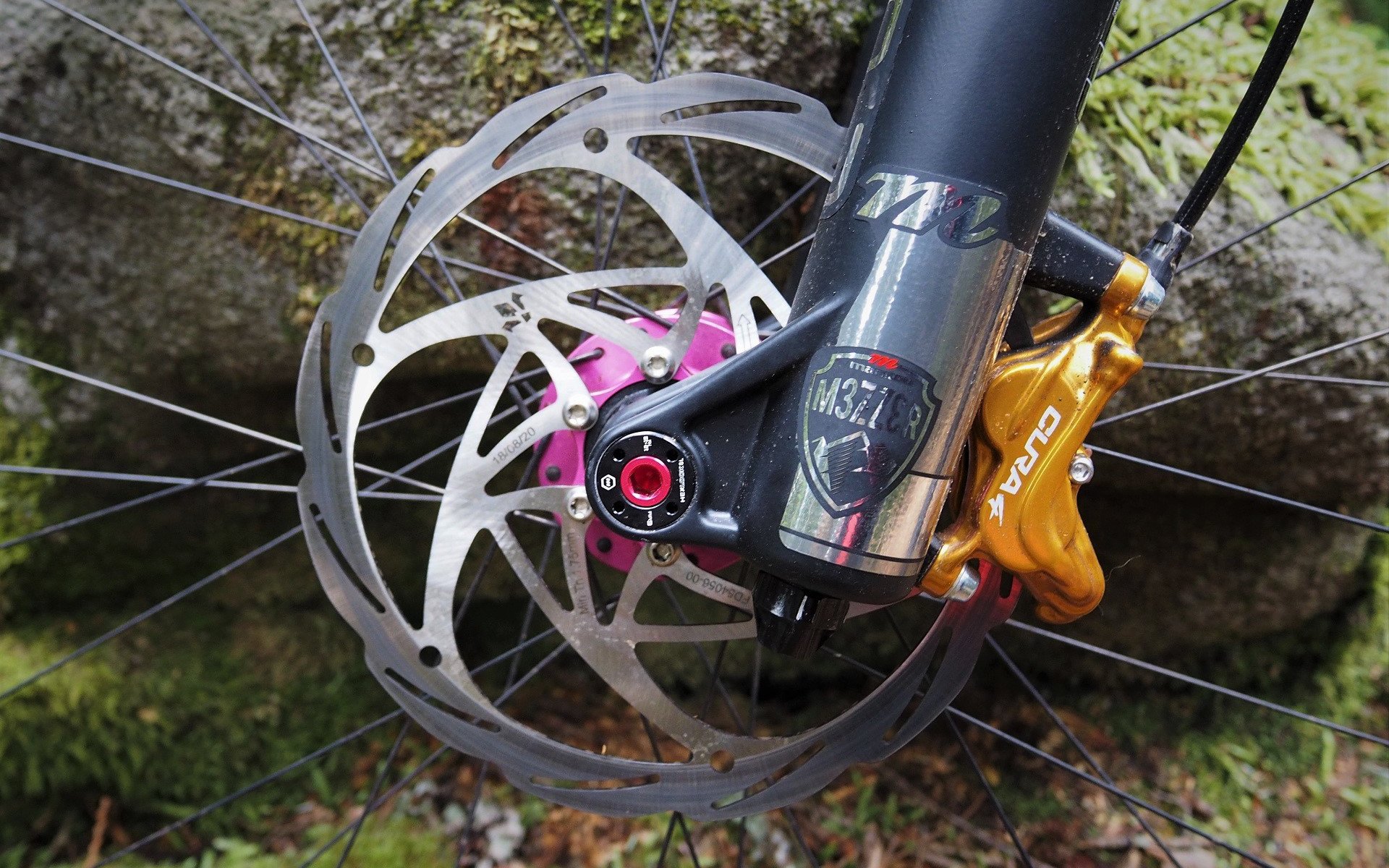
REVIEW
Formula Cura 4 Brake Review
The Formula
Formula has been manufacturing mountain bike disc brakes in Italy since 1993. Their press claims theirs was 'the first disc brake in mountain bike history' but to be fair it was the first hydraulic system with Hope and possibly other companies producing cable-actuated systems previously. Regardless, as much as I'm happy with cable-actuated brakes on my commuter, I think it's fair to say that Formula opened the doors to modern mountain bike brake systems and it's reasonable that they're quite proud of the achievement.
The relative success of their systems for aggressive riding has ebbed and flowed with Nicholas Vouilloz racing and winning on their brakes in the 90s, significant aftermarket popularity for their 'The One' system around a decade ago, and recently an impressive World Cup DH resume for their 2-piston and now 4-piston Cura brake systems.
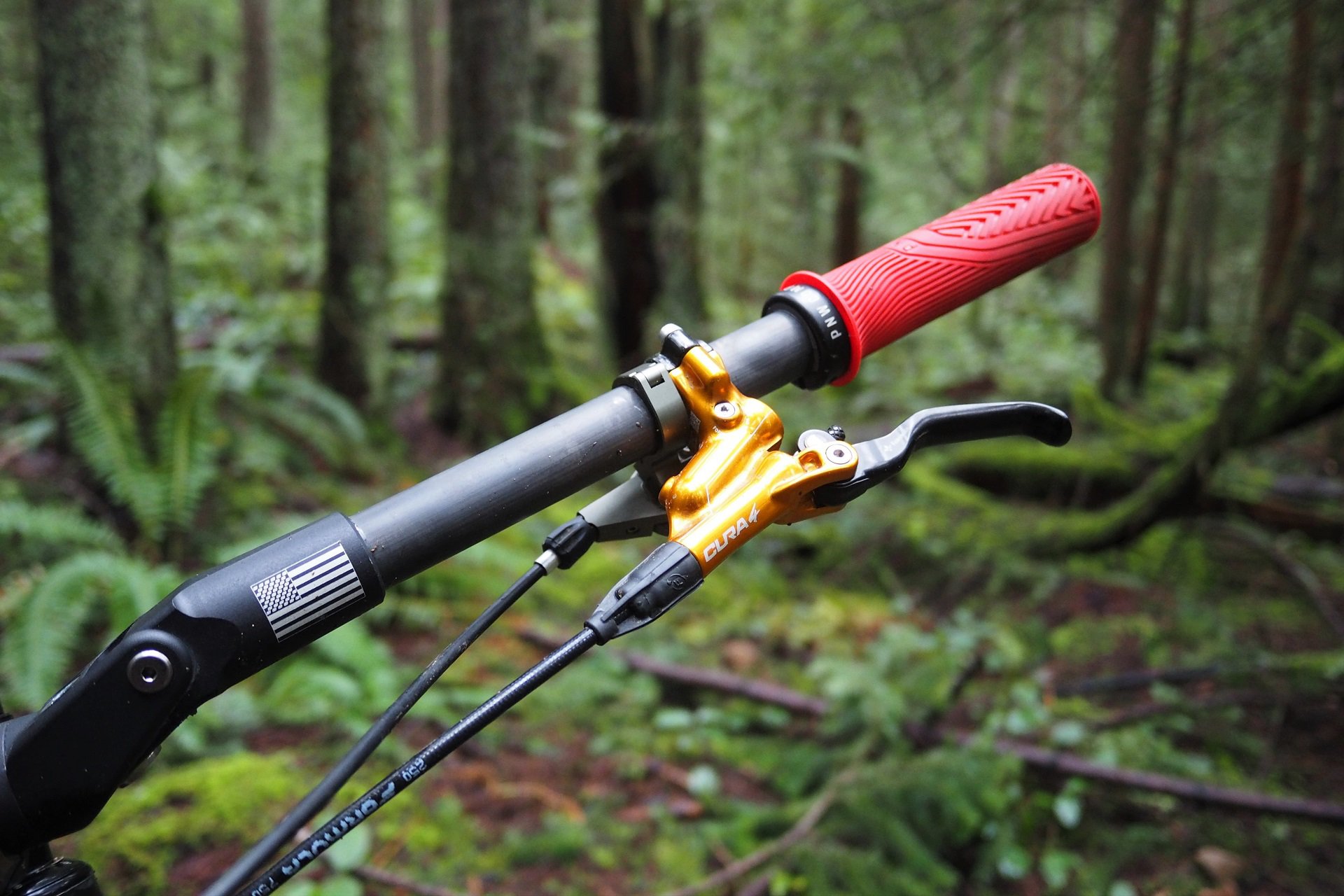
Gold Formula Cura 4 on test on my Marin. I used both their consistent sintered compound and their new resin brake pad option.
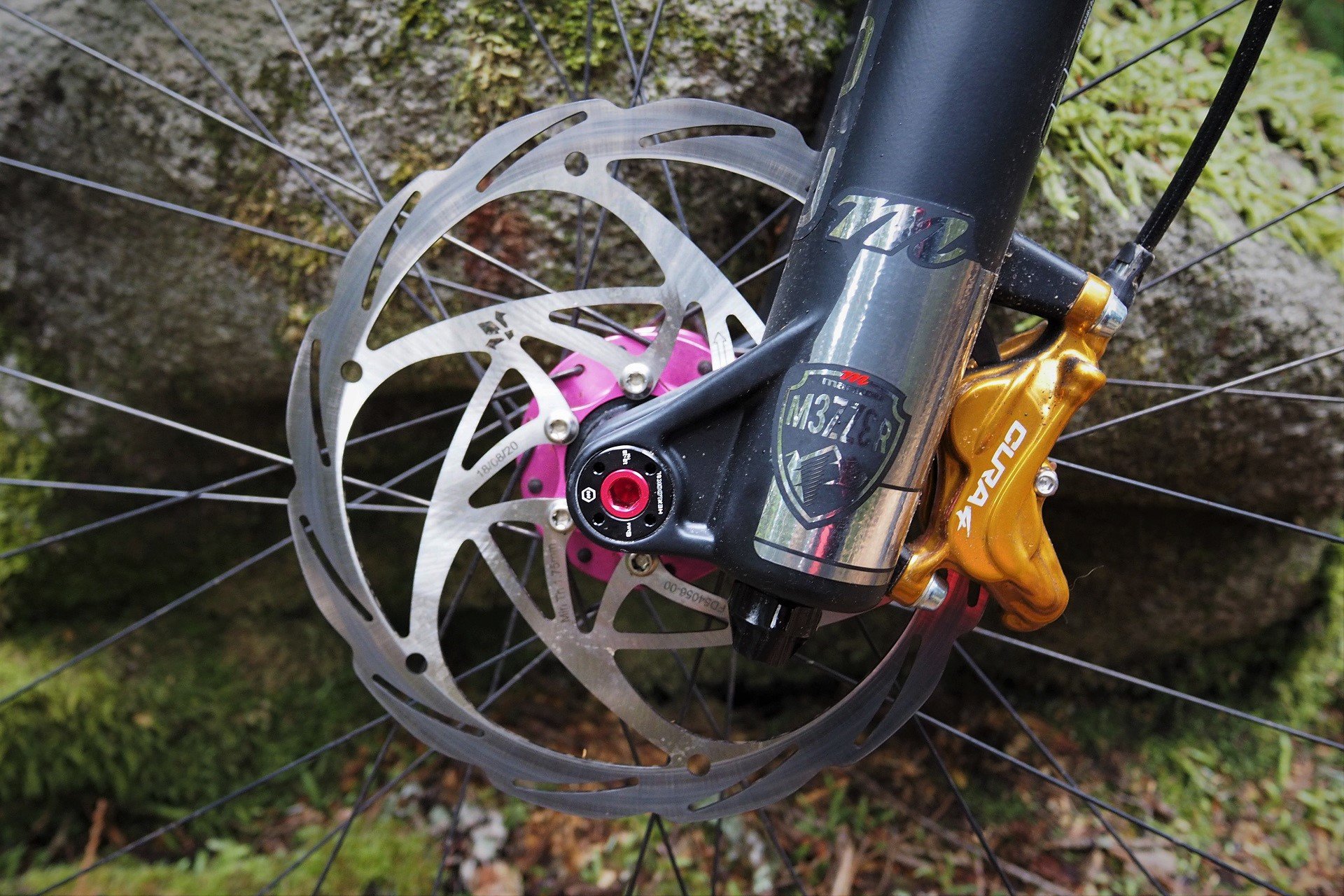
The latest one-piece steel Formula rotors aren't as fancy looking as some of their previous setups but they are the quietest to date.
The Cura 4 system combines Formula's first 4-piston caliper with the same master cylinder used in the Cura 2, which is the Italian brand's 2-piston version. Same bleed kit and process, same mineral oil brake fluid, and Formula’s first new brake pad in a long time.
The system is simple, with a minimal number of parts that are all replaceable. It's fully rebuildable, has plenty of leverage at the brake lever, and a classic, positive, consistent, feeling where the harder I pull the more stopping force I get at the rotor.
An Easy Podium
I have no reservations in stating that, I think, two of the best brake systems on the market were released in the last calendar year. Throwing aside budget, just for the moment, and without taking aesthetics into question the Hayes Dominion, which Cam and I recently reviewed, and these made-in-Italy Formula Cura 4 brakes have ruined a lot of other brake experiences for me. My personal podium is based on that magic combination of best power and feel. I'm not counting grams, and I think more riders are looking for components that are more serviceable.
I have a lot more to say about these brakes, but I wanted to get it out of the way because like no other product I've tested, I've felt pressure from NSMB readers to write this review. Formula has been making quality brakes for ages, and I've previously tested the unique oval-piston ROR and their first mineral oil option the Cura 2 with good results, but their first foray into four-pistons are the brakes I've been asked about the most times in my years test-writing for NSMB. Despite having some theories, I frankly have no idea why, but the bike geeks are hungry.
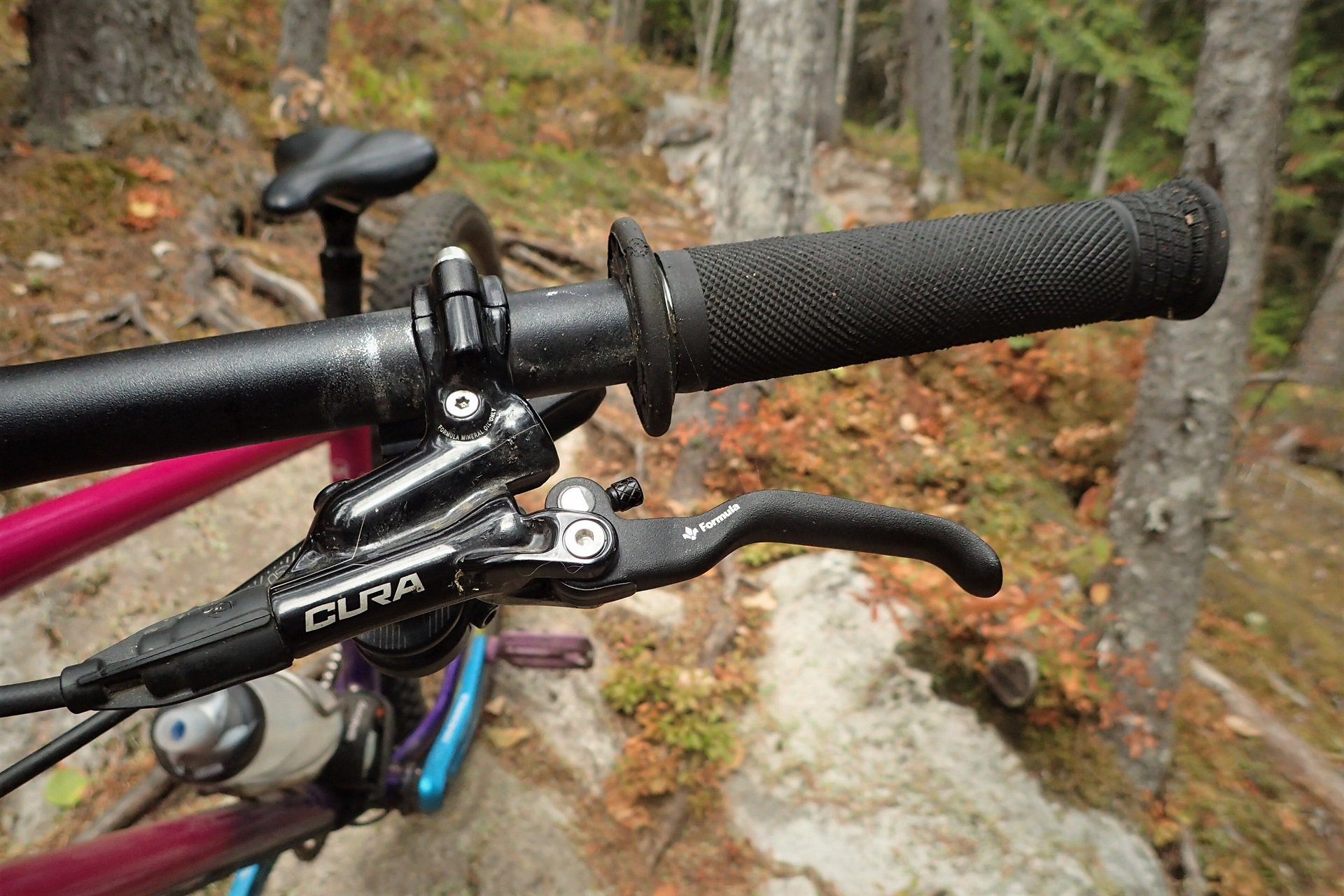
The master cylinder is the same as the Cura 2 brakes I previously reviewed.
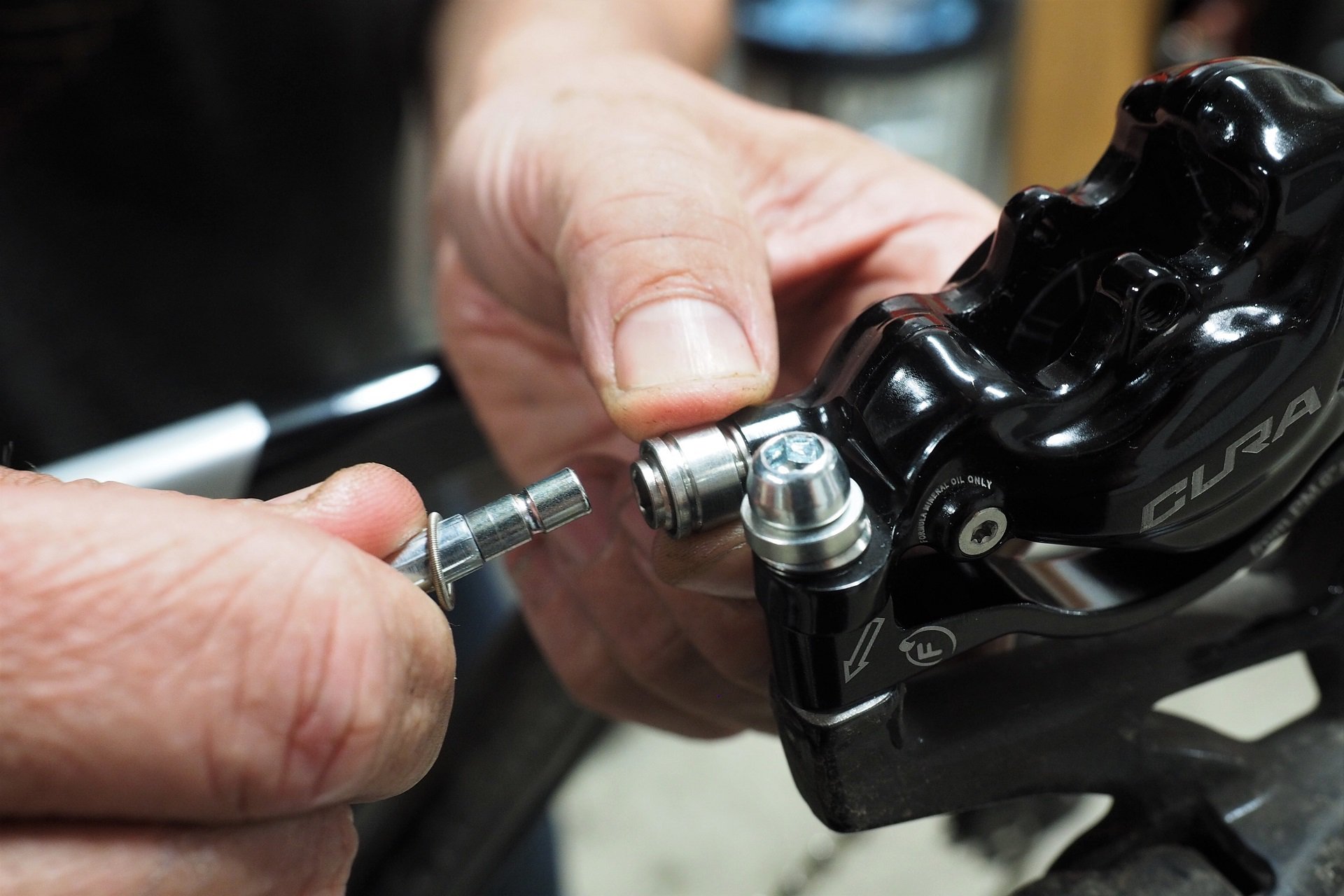
The Cura 2 and Cura 4 also use the same brake lines with the quick connect option available as an upgrade.
Making a choice between the best brakes is trickier, especially if you're adding in the shear availability of the excellent SRAM Code lineup and Shimano's proven four-piston brakes. Without taking into consideration brake rotors the Dominions have an SRP of 230 USD per wheel, the MT7 clocks in at 240 USD per wheel, and the Cura 4 will set you back 210 USD per wheel. I'm not saying that 40-60 USD is nothing but the right set of brakes is the right set of brakes.
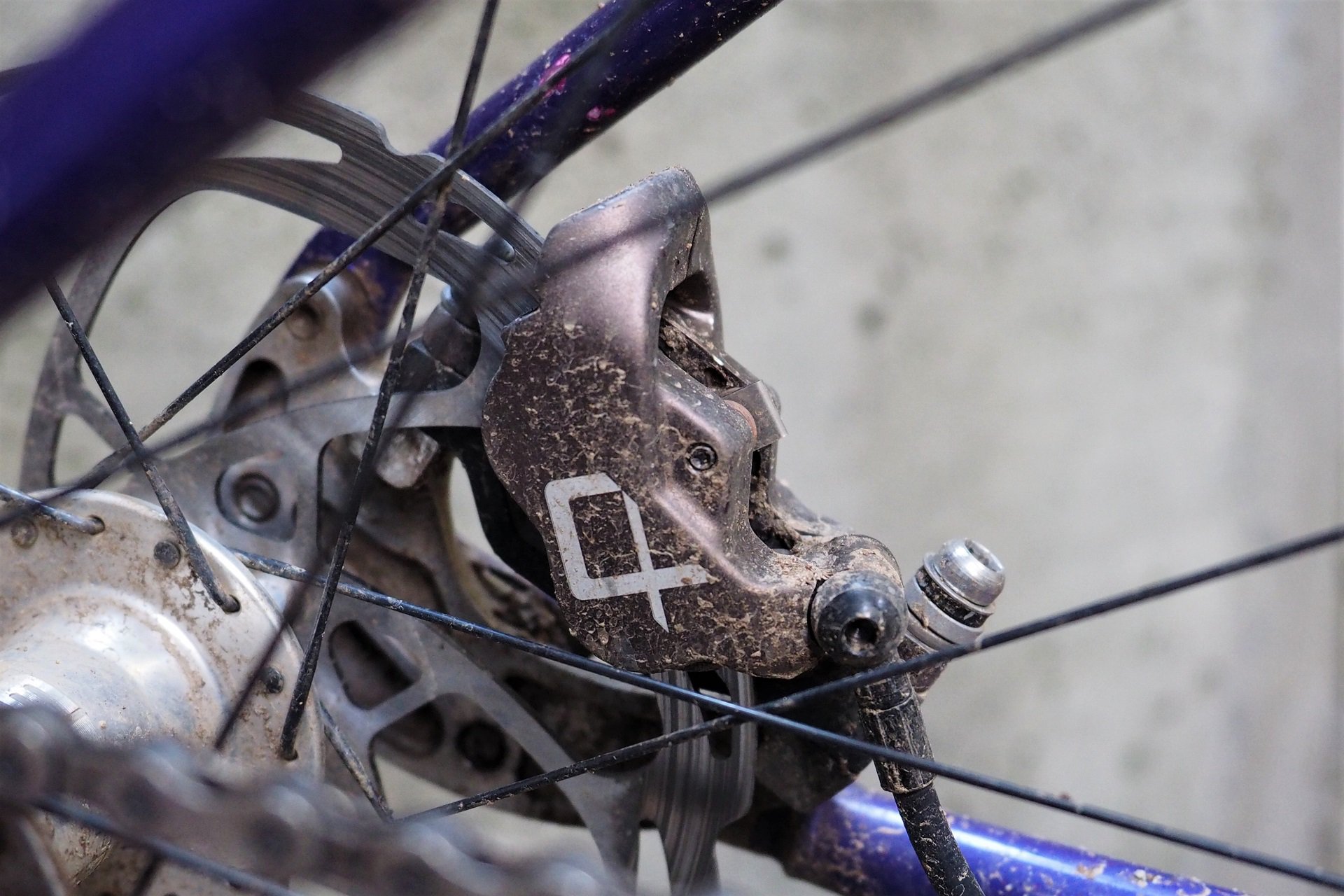
The absolutely massive Hayes Dominion four-piston caliper is paired with their master for the lightest lever action on the market.
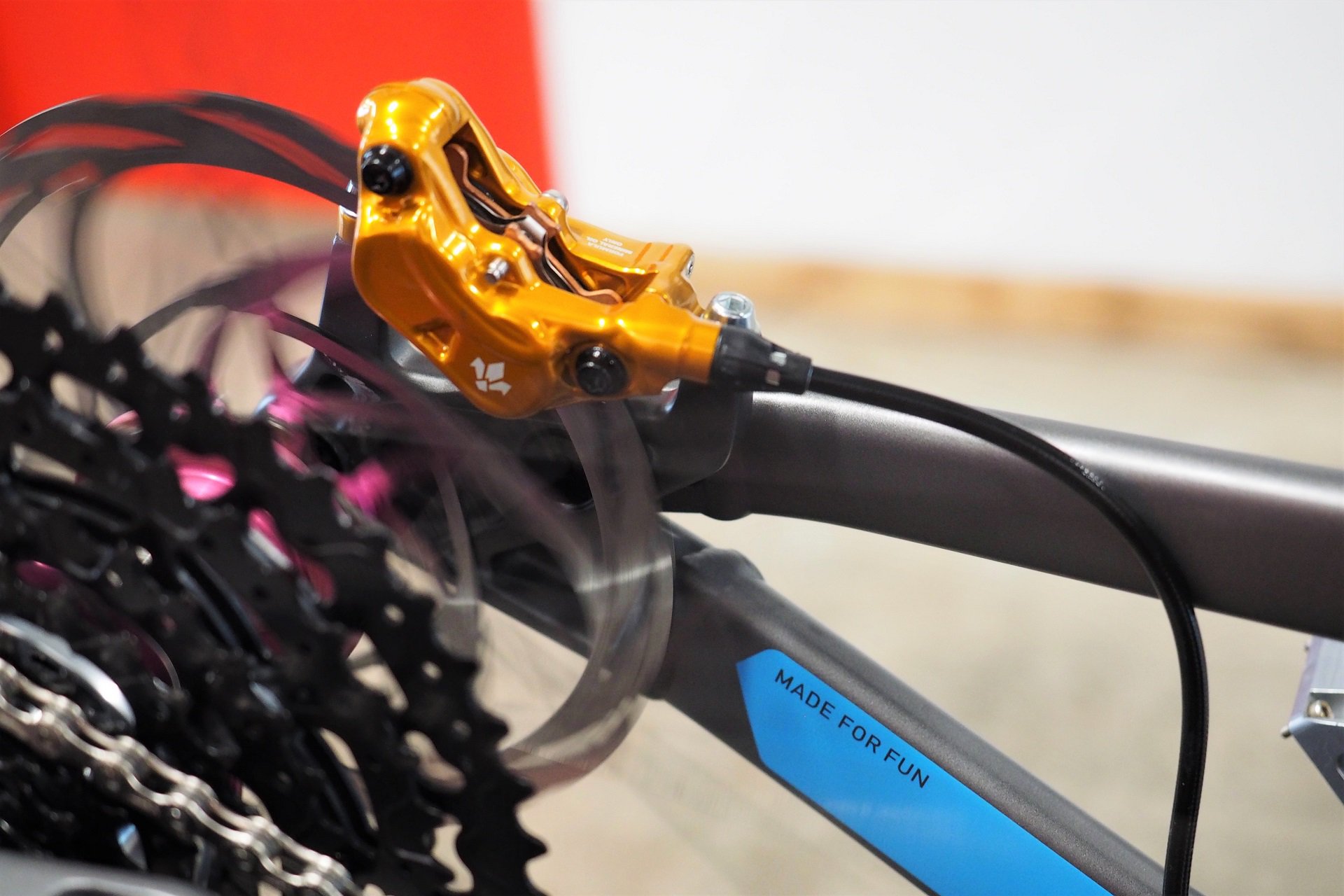
The Formula Cura 4 four-piston caliper and their long lever blade combine for power and modulation with a classic, progressive, feel.
Teardown
For an in depth look at how these function, check out the first impressions & teardown I produced with Bikeroom-Jeff. I won’t review that entire process here, but I want to mention that the Cura system is the fastest fully-serviceable system to tear down and rebuild that Jeff and I have done. It’s also one of the friendlier systems to bleed, not just because it uses a SRAM-esque dual-syringe process but, also because the simple architecture lends itself to helping air escape.
I've never had brakes run drag-free with so little effort that didn't rely on some addition pad-moving voodoo magic like Shimano's Servo Wave or SRAM's SwingLink. That’s across two sets of brakes. About halfway through the test period, I purchased a set of Cura 4 calipers to update the Cura 2 brakes that have been living on my hardtail when I'm not testing something else.
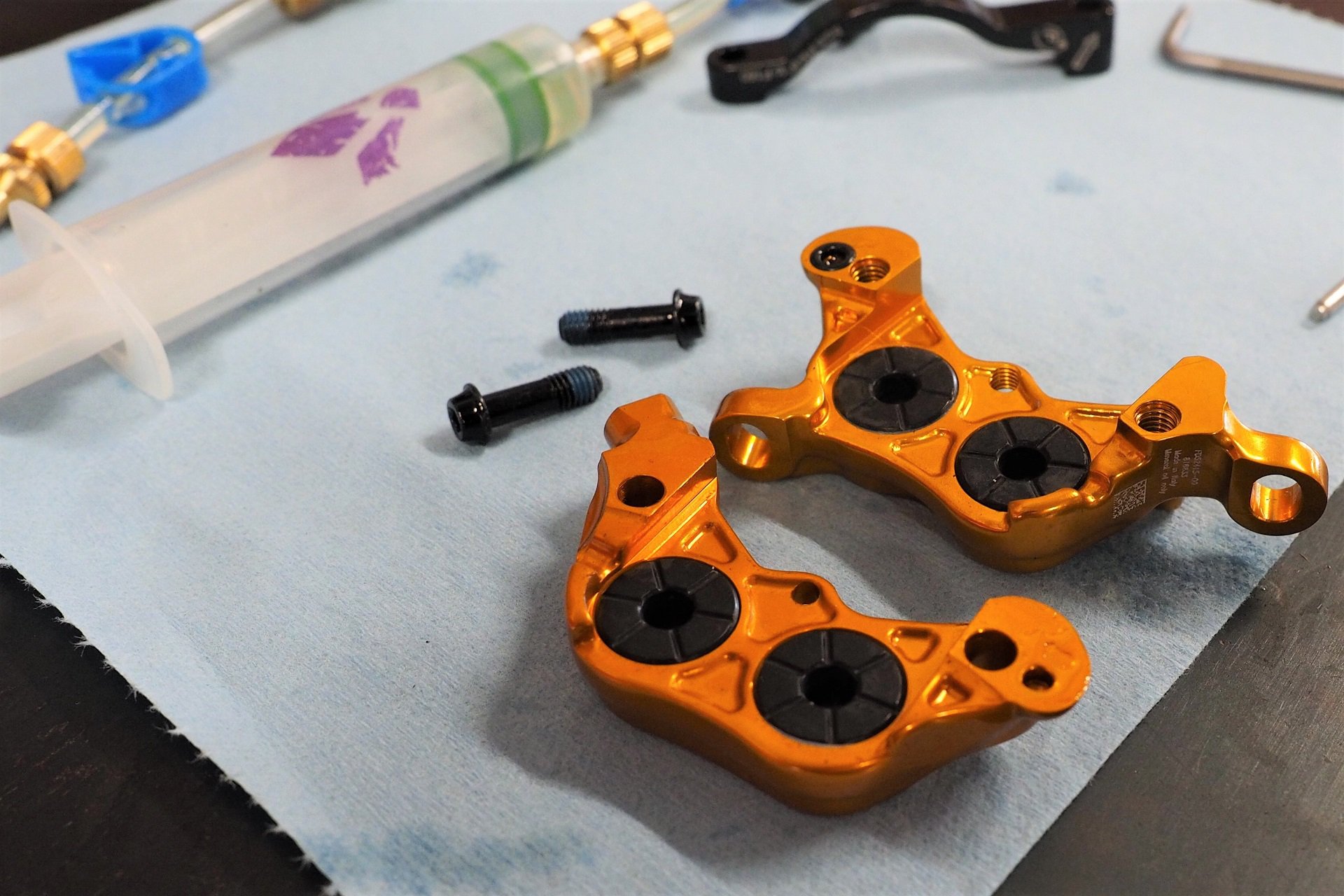
All small parts are available aftermarket including the seals for the four matching 18mm pistons.
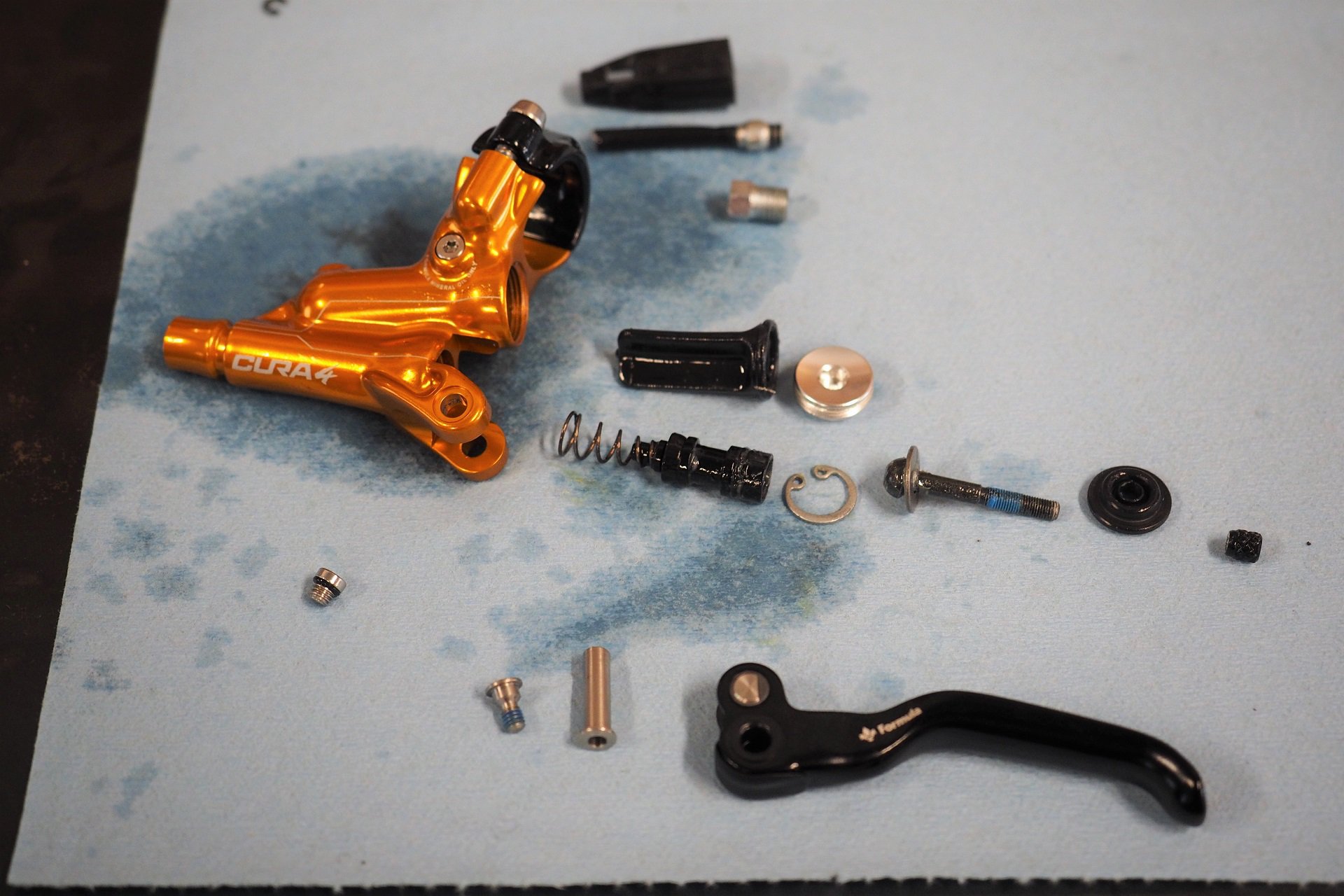
The master cylinder is also a beautifully simple affair with good parts support in my experience. A piston kit is about 15 USD.
I have been asked about the value of rebuildable, versus replaceable, components v. the average mountain biker's mechanical abilities. While I don't expect that even 20% of riders would teardown their own brakes, any decent bike shop will have a tech who can replace a caliper seal in a Cura and I think it's a lot nicer to replace a few seals than to buy a whole caliper.
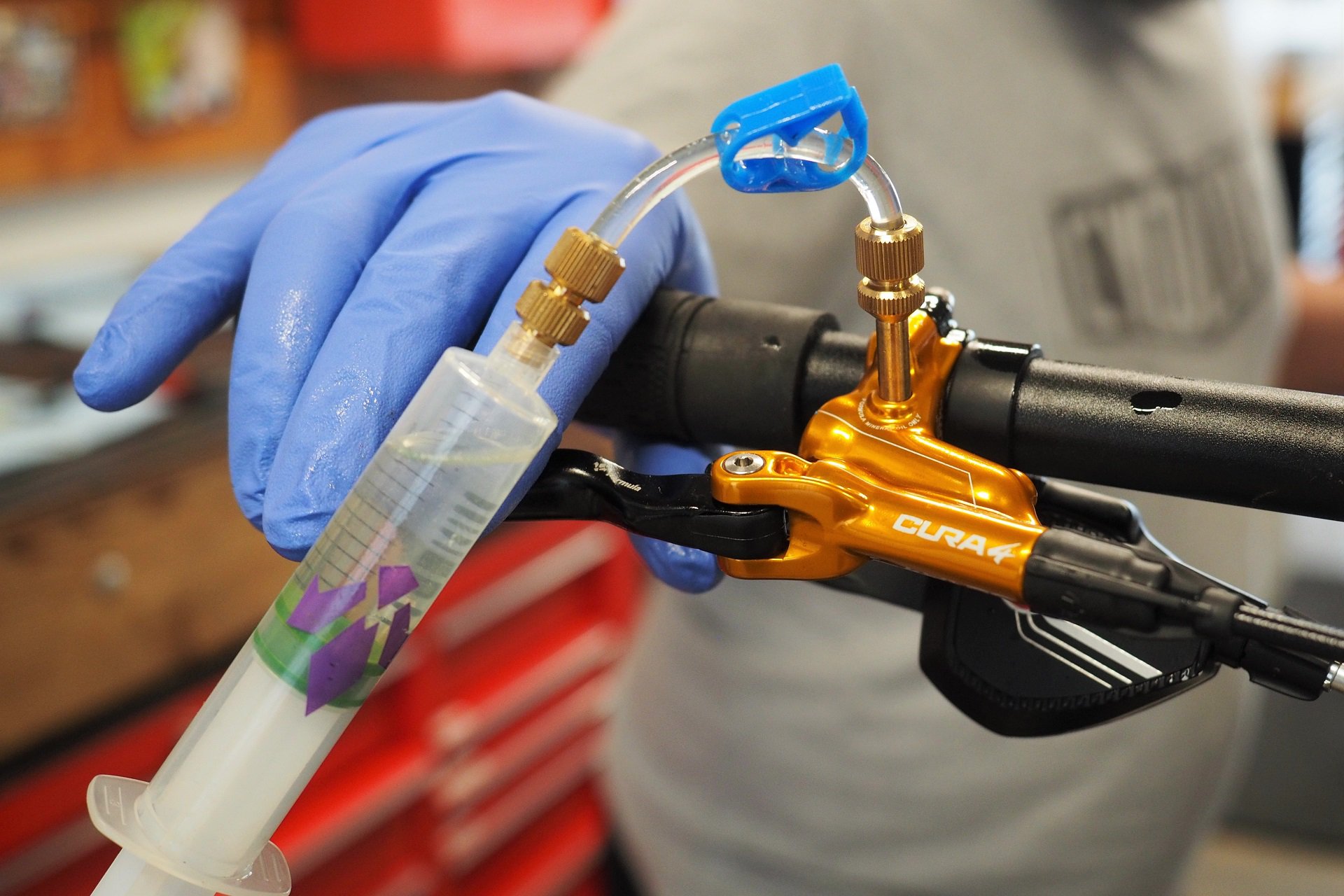
No reinventing the wheel here. If you can bleed SRAM brakes you can bleed the Cura.
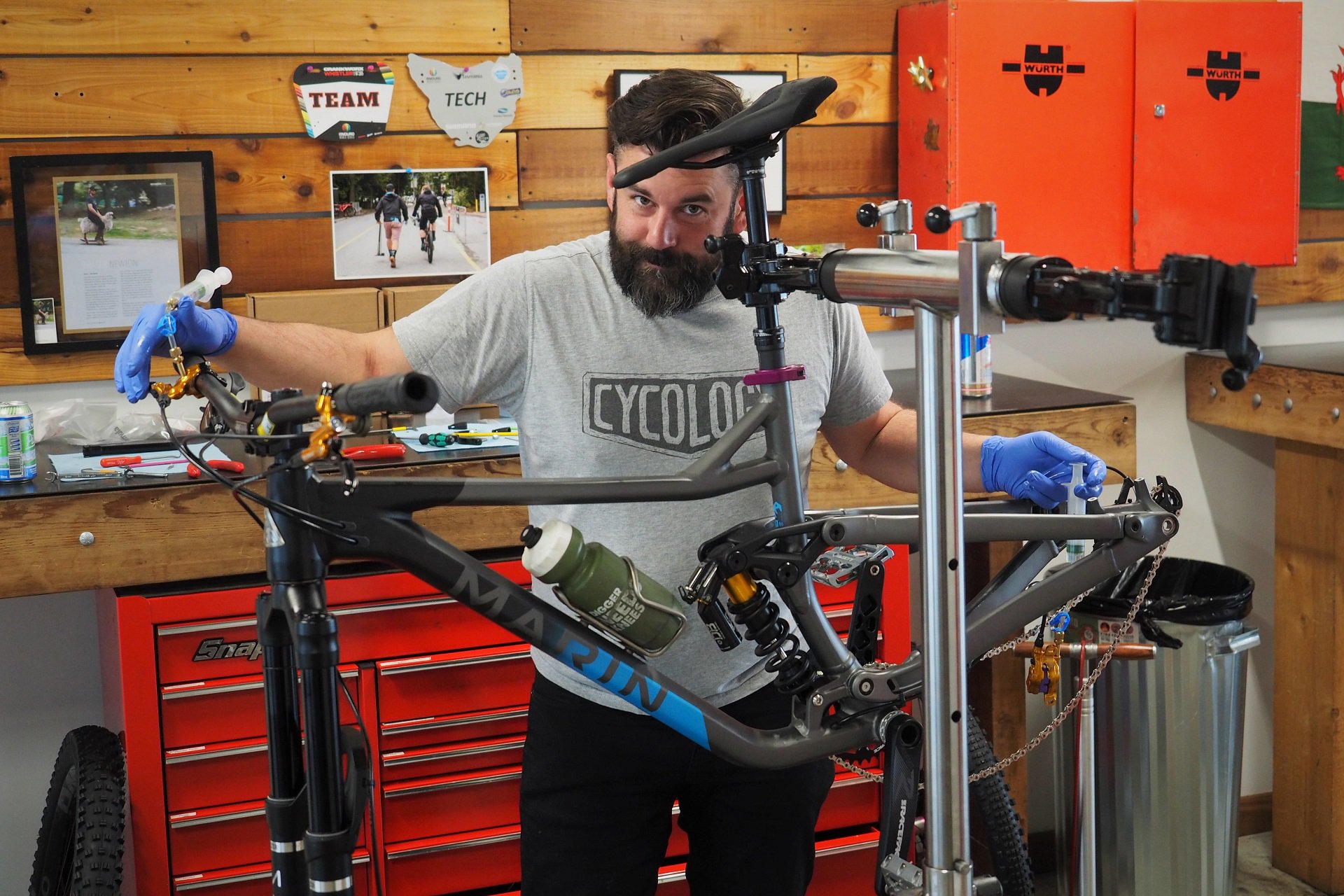
Jeff's chasing out all the tiny bubbles. All my Cura bleeds have been quick and perfect.
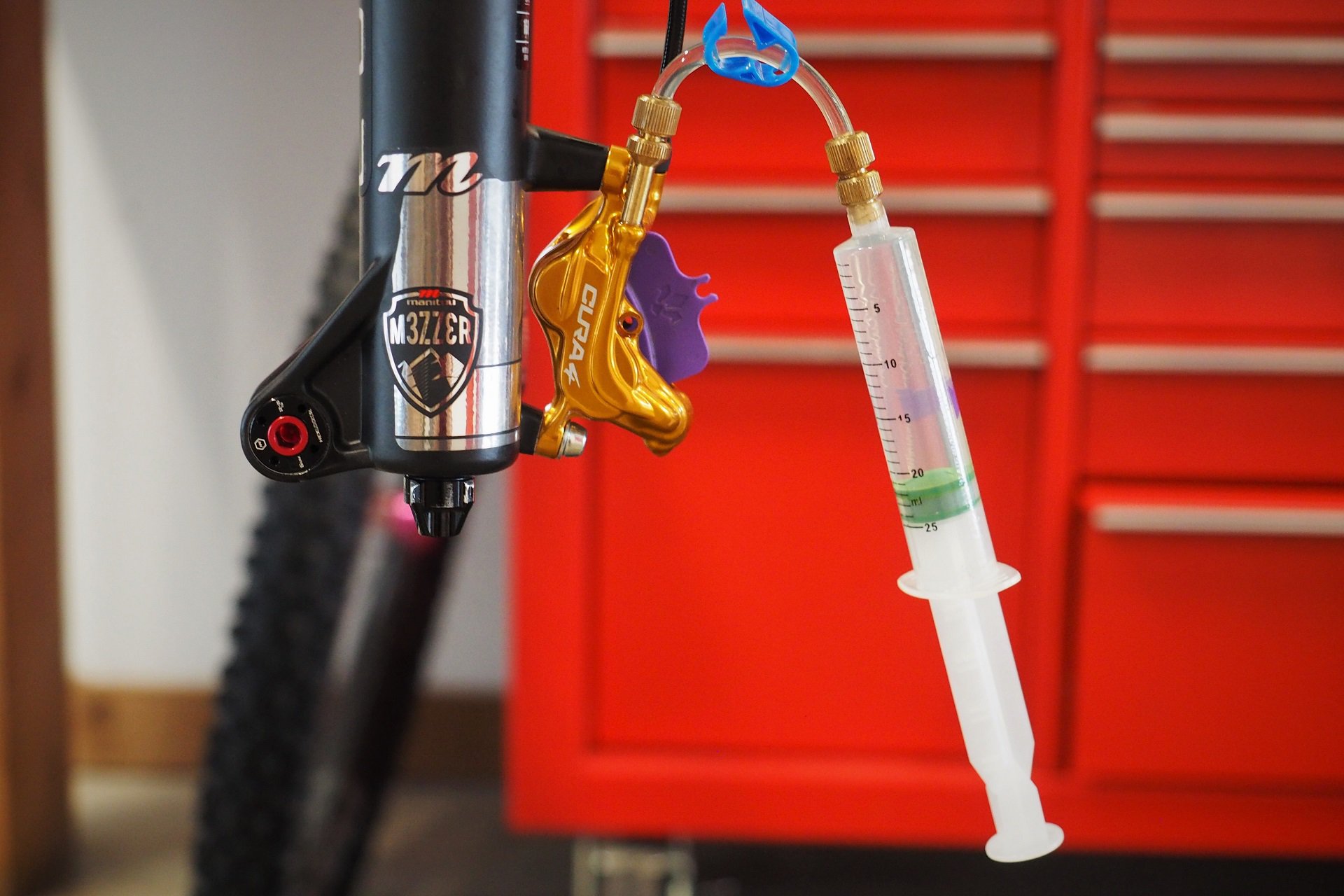
You can just push up from the caliper into a batch bucket at the master, but the two syringe system wins for consistent bleeds.
Sintered v. Organic
My previous experiences with Formula brakes put them solidly in the same brake-pad camp as ShRAMano, which is to say the only pads worth buying are the sintered models. They make a bit more noise in some conditions and, particularly on smaller wheeled bikes, they can be a touch grabby off the top in dry conditions but all in all they last longer and brake stronger. All of Formula's other brakes use the same pad but the Cura 4 has a longer version.
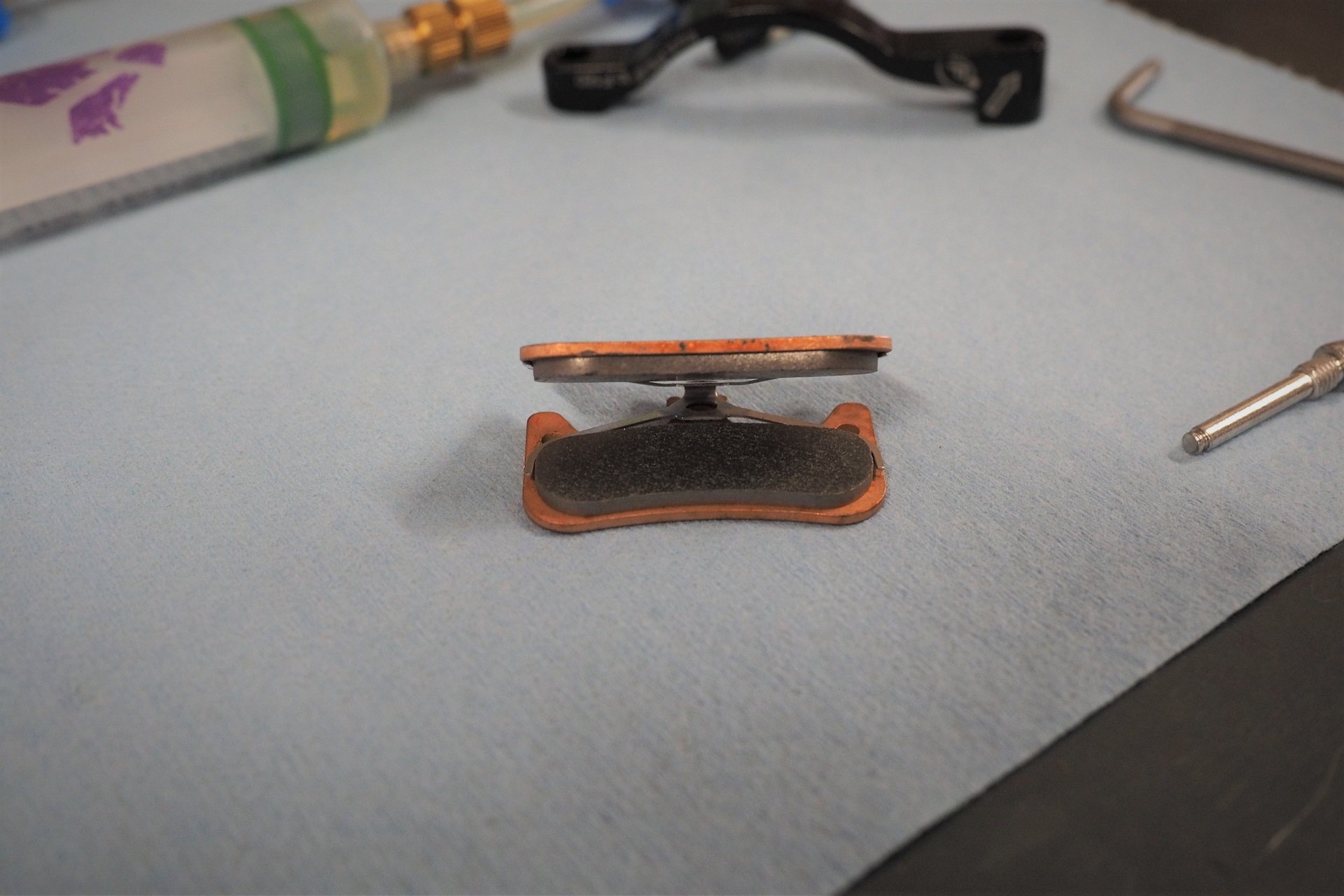
Formula's first new pad shape in years was necessitated by the four piston caliper. Here are the go-to sintered pads.
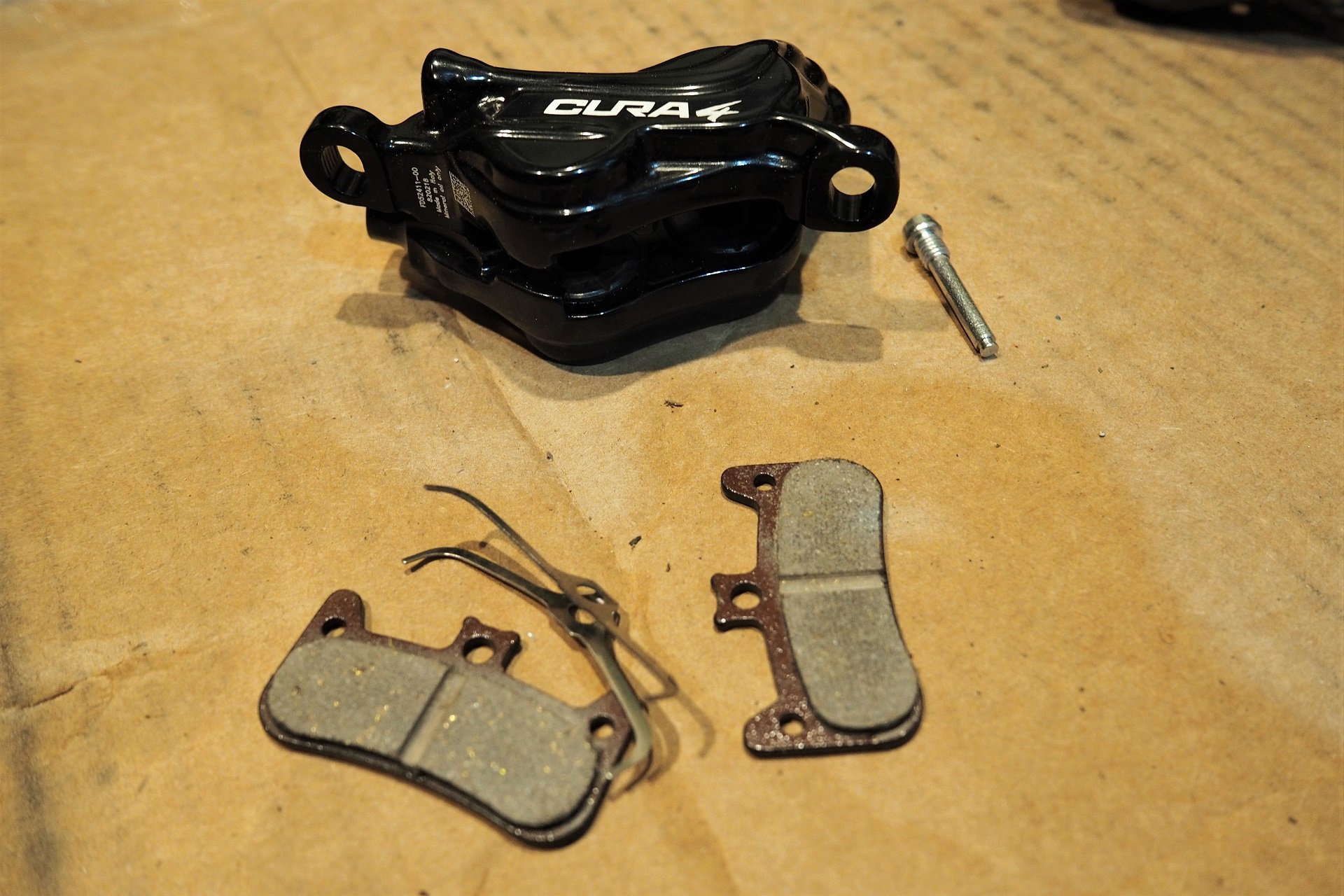
These are the brand new Resin pads that Formula is touting. They have less initial bite but similar deep power in addition to adding a bit more modulated feel at the levers.
Formula also sent me a pair of their latest resin-compound brake pads to try out. I'm less skeptical of higher-end resin pads after all my experiences with Magura, and these pads actually live up to their billing. They have a bit less initial bite than the sintered pads, particularly noticeable with 29" wheels, but trade that for quieter performance, a nicer initial feel at the lever, more modulated braking, and similar deep power when I'm fully on the binders.
The sintered pads last longer, although possibly at the cost of rotor wear though I've never tracked it. I particularly was fond of the resin pads on my hardtail where traction isn't as consistent as on my 6" travel full suspension bike and the little extra power modulation helped me keep things in control.
Based on lifespan I'd probably put my own cash into the sintered pads in either event for the extra $10 a pair but I can confirm that next time I'm actually pulling the trigger on pads for my hardtail because the Resin pads are sort of glorious on a greasy day.
Upgrade Bias
One cool thing about the Cura system is the master cylinder accessory clamps are interchangeable with Magura, and also some Hope brakes. Have I mentioned how much I love my Wolftooth ReMote?* Actually, in all seriousness, I like Formula's solution for mounting up SRAM shifters and have used it with both the companies' systems.
*I couldn't resist the running joke.
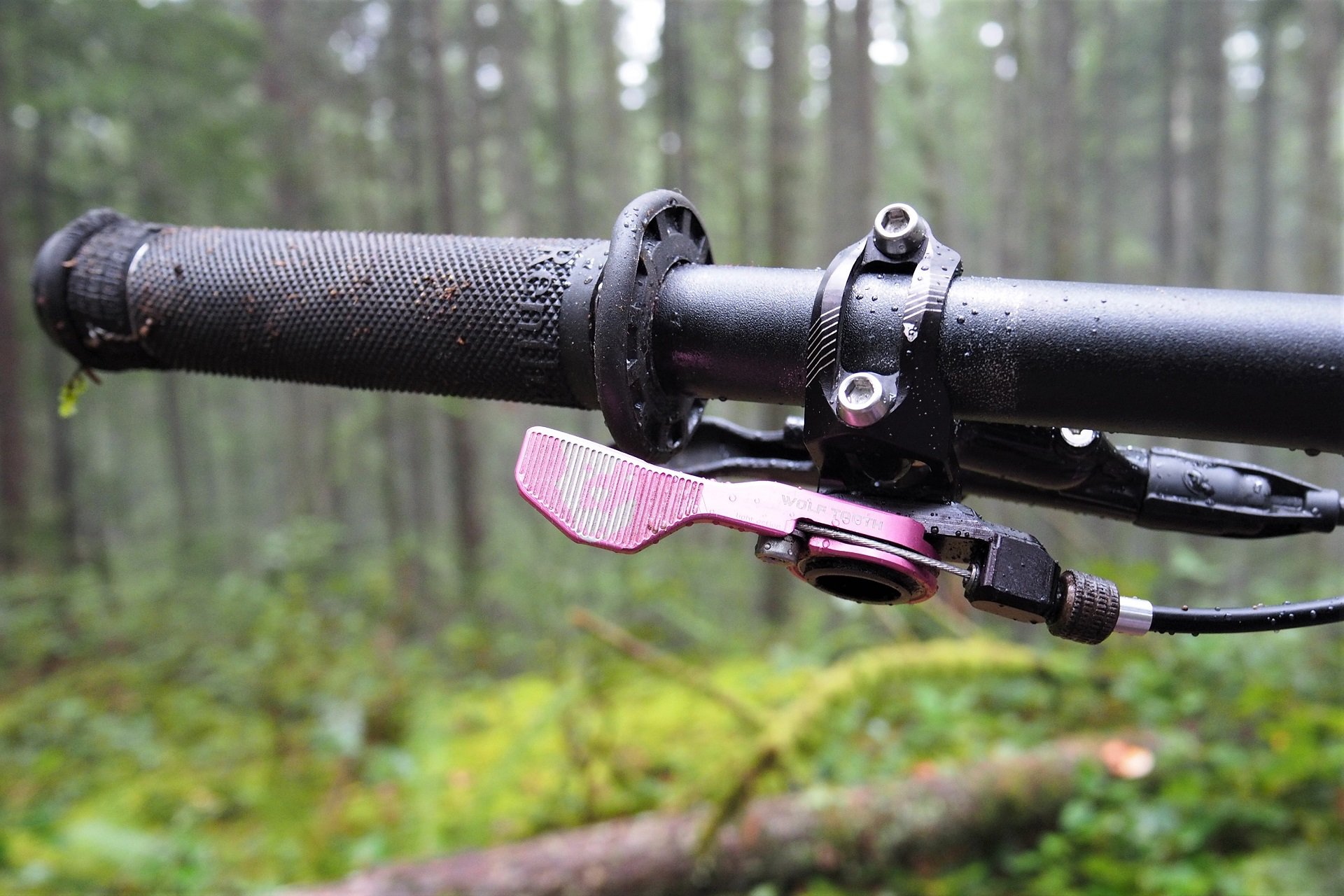
Magura Wolftooth ReMote mounted on my Formula Cura master cylinder.
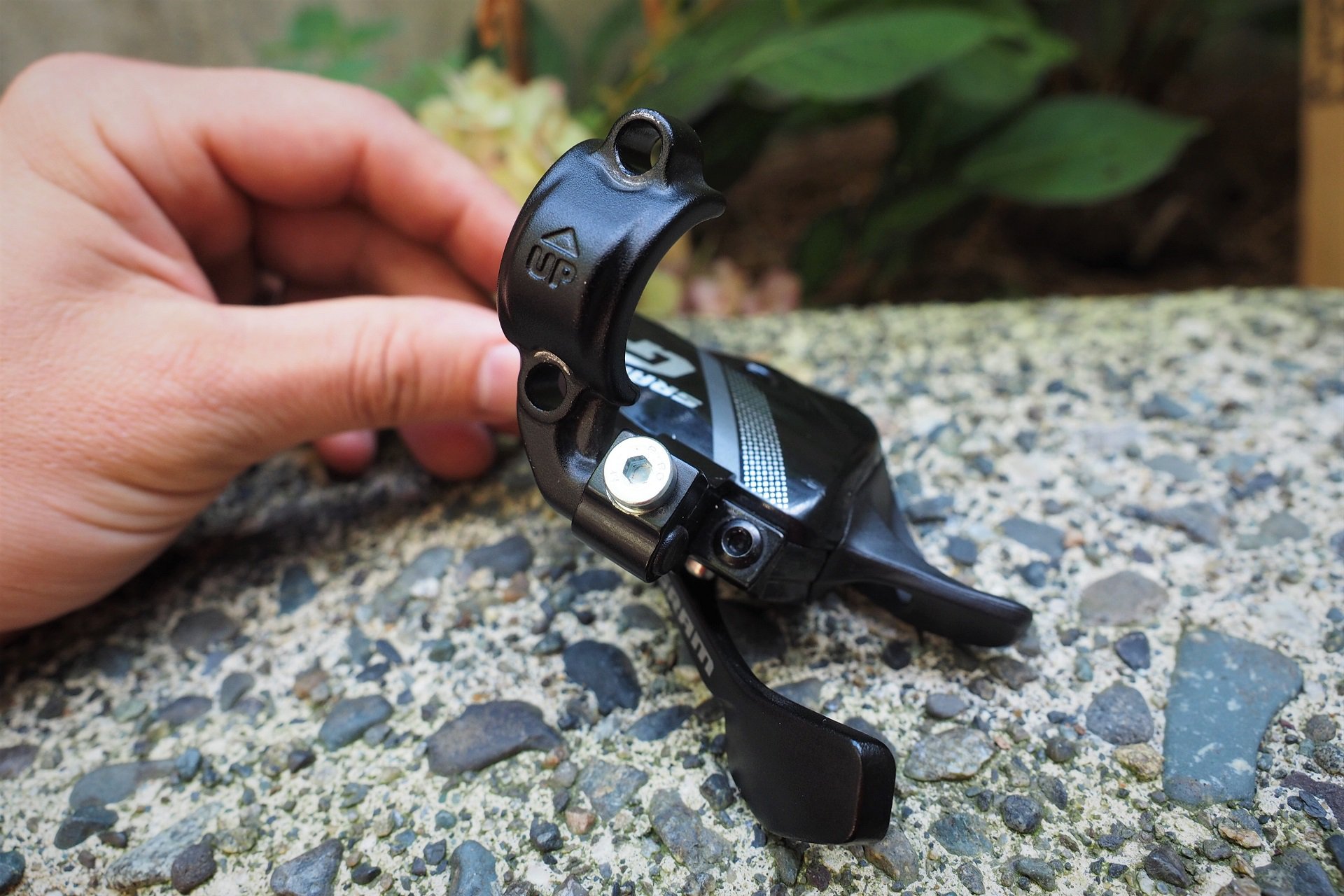
Formula's simple solution mounts a MatchMaker compatible shifter on a post.
The Cura 4 is such an improvement in control, even more so than power, that the 2-piston Cura 2 model I'm been running on my hardtail becomes a bit of a let down.
The solution here was easy since the Cura systems share a master cylinder assembly I simply bought a pair of 4-piston calipers and it was plug-and-play to set them up with a quick bleed that I was due for anyways. I have had to rebuild one of the Cura 2 master cylinders. There was no performance issue but it was squeaking on compression,. Otherwise, it's just a matter of swapping pads and a yearly bleed to keep them running.
Cura 4 Brakes
When it comes to choosing which set of DH-powerful four-piston stoppers to buy there are a lot of factors to consider from how easy it is to buy pads in a pinch (I keep an extra pair of Cura pads at home), to how easy they are to bleed, how much they cost, and finally how long a system will deliver good performance before a fresh system, or a full refresh, becomes desirable.
There's also the ergonomic factor; how the blades feel against your fingers and how the brakes feel in use. There's a huge difference between the lightest-action ever of the Hayes Dominion and the heavier, more positive feel of the Cura 4. I didn't have any issue modulating either system or SRAM Code brakes, or Magura's 4-piston MT series brakes, but there are notable differences in feel that are going to determine to influence the decision.
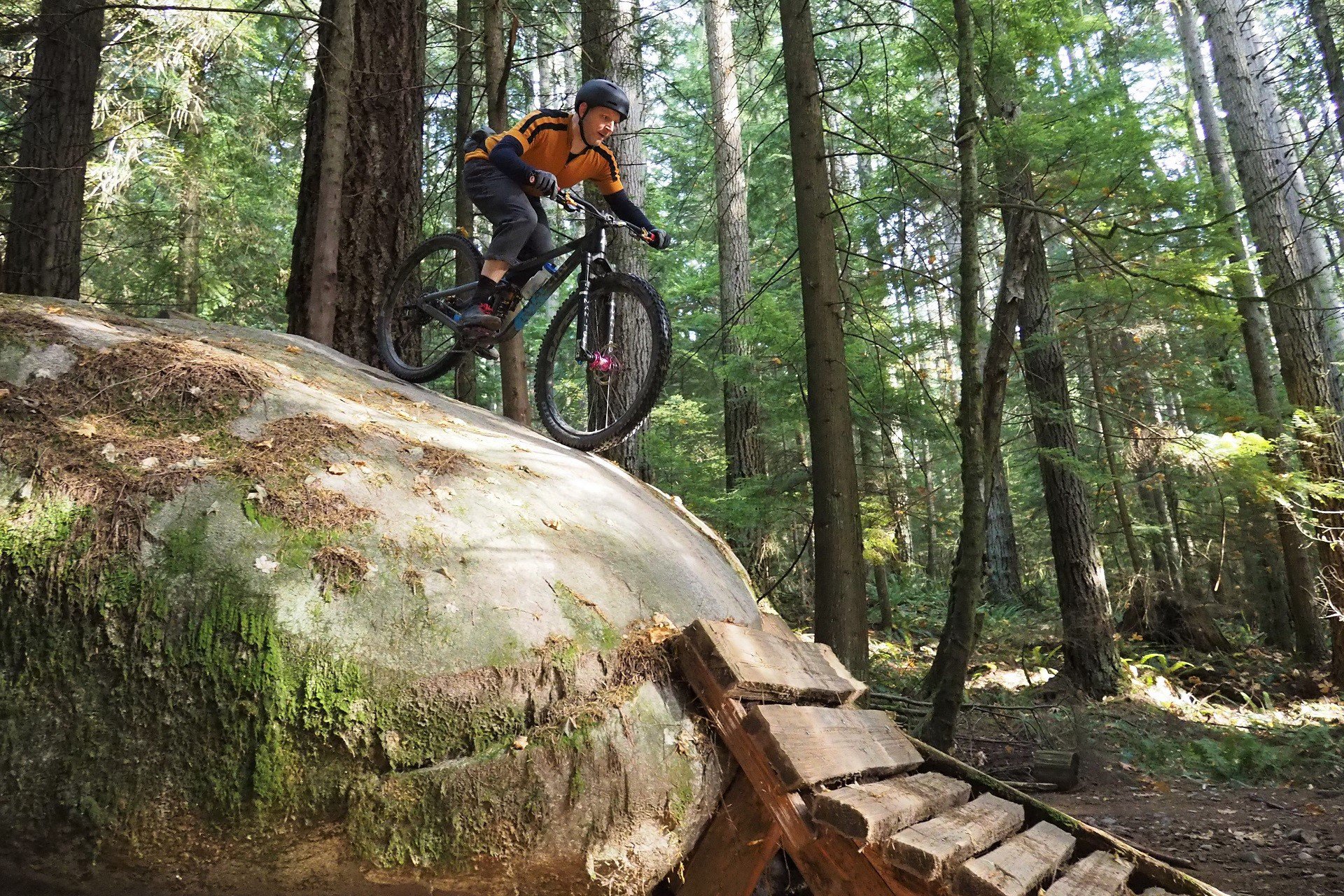
Power and modulation in all conditions with a positive feel. I did most my full suspension riding with the sintered brake pad option.
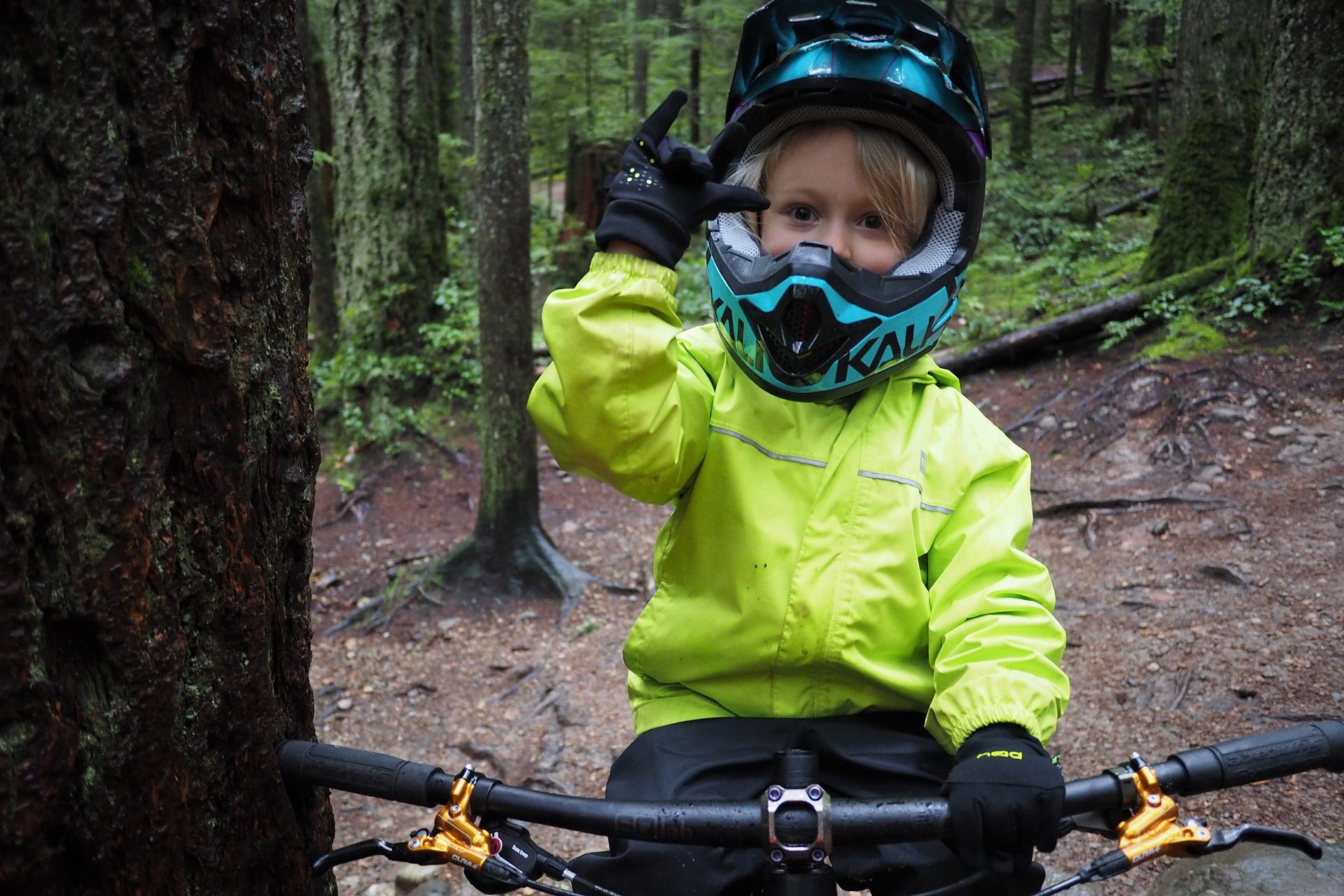
For a really thorough test I added 45lbs to the front of my bike... no just kidding, I love this photo and it's an excuse to plug the KRS seat.
This testing process is a little irregular in that the Cura 4 was love at first squeeze for me and never gave me a reason to change my mind. They have a positive feel that delivers the level of feedback I've come to like from using Magura brakes. The long lever blades provide plenty of leverage and easy to control power. Aesthetically they don't have a bunch of big tool-free adjusters I'll use only once and I like the clean, organic, look. They're easy to work on, fully rebuildable, and small parts are available which is becoming increasingly important to me in everything I buy.
Are they the best brake system on the market? Impossible to say given all the metrics that go into a personal determination but I absolutely believe that, like the Hayes Dominion, they're a system you should squeeze before upgrading those woefully under-powered brakes that came stock on your new million-dollar long travel 29'er.
Out of the box, they're a competitive 210 USD per wheel before rotors. For more information check out the Cura 4 at Ride Formula.
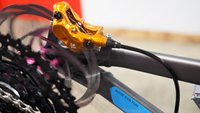
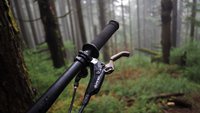
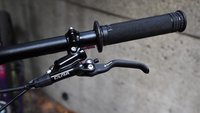
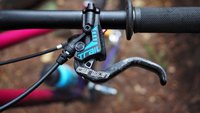







Comments
fartymarty
4 years, 1 month ago
I can't wait for the upcoming review on these https://fasstmtb.com/
They bring back memories of the Girvin Flexstem...
Reply
Andrew Major
4 years, 1 month ago
That’s just cruel! They go from +6* upsweep to flat and they’re designed to be used in conjunction with a suspension fork not in lieu of one. Nothing like the flex stem in either ride or philosophy!
Reply
fartymarty
4 years, 1 month ago
There was a health lashing of sarcasm dished up with my comment...
My first suspension forks were Manitou 3's so I am immediately sceptical of anything with an elastomer.
Reply
Andrew Major
4 years, 1 month ago
But yes, lots of interesting (hopefully) things to say in the first look. Love that they listened to customers and did the 12* backsweep version.
Reply
Shinook
4 years, 1 month ago
I wrote a bunch on these in another post that I can't find now, but I ran them for a while and really liked them. I have ulnar nerve damage in my left hand and they helped better than anything else I have tried, although significant changes in diet and exercise habits off the bike have reduced it dramatically since. The surprise for me was how they helped with control of the bike, it feels kindof like adding CushCore or more suspension, it gives the bike a bit of stability it feels esp. on chunky stuff. There are a lot of benefits for people that don't have issues like me, but they definitely helped me with my hand pain.
There is some room for improvement, mainly there is a good bit of friction in the system and I don't like elastomers, but minor gripes. The only major complaint I had is that I felt the softer two elastomers were kindof useless, I'd rather see more granularity in options around the middle firmness setting, but the two elastomers in the middle (yellow and red) were the ones I found the most useful.
If you have hand/arm/shoulder issues, they will probably help. They also have a 30 day return policy (https://fasstmtb.com/pages/3), you can try them and return them if you don't like them or they don't help. Their support is great, as well, I spent well over an hour on the phone with one of the owners discussing their bars and our hand issues.
Not to steal Andrew's thunder, but those are my impressions. I'm anxious to hear his thoughts, also.
Reply
Andrew Major
4 years, 1 month ago
We’re getting deeper into final review thoughts here but I really don’t see what you use other than elastomers to control compression and rebound here.
Anything else is going to be heavy, more expensive, and more complicated and there really isn’t space/architecture for say carbon leaf springs.
Fasst Flexx is playing around with different rates / composition for the elastomers and I have a few options to try.
.
My initial impressions are in the right circumstances (especially with a lower end fork) anyone would notice the difference the bars make, and as with their moto stuff, for the right rider these have the potential to be ride altering - I think that lines up with what you’re saying.
Reply
fartymarty
4 years, 1 month ago
Andrew - These bars feed into the bigger discussion of hand / arm fatigue / bike stiffness which would make a very interesting article / discussion piece.
Shinook - I have a ton of other questions about these bars but will save them for the article on the bars.
Reply
Shinook
4 years, 1 month ago
You are welcome to reach out to me directly if you like, I'd be happy to answer any questions you have based on my experiences.
Reply
Andrew Major
4 years, 1 month ago
I will indeed! After the first look is done.
Andrew Major
4 years, 1 month ago
Now I’m going hard tangent, but don’t see where else these thoughts would go - so to the comments on Formula brakes with them!
Mountain bikers hate elastomers. I get it. Who didn’t have a friend almost drown because the elastomers in their Onza or Speedplay pedals froze mid-puddle, or gave a Judy go rigid because the bumpers got hard or etc,
BUT, I was thinking the other day about trying to create coil forks that are progressive in the end stroke like air and f-me if the old type-2 Judy springs didn’t come to mind. Just make the coil way longer and the elastomer part way shorter. Let folks mix and match elastomers to control progressively. They’re light, cheap, and they’d be perfect for the application?!
Reply
Shinook
4 years, 1 month ago
You are correct: it was ride altering for me. It was the difference between being able to finish some DH runs without stopping at all vs having to stop 1-2 times to let my hands cool down. They made a huge difference for me and I think/wish more attention was given to the health of our hands and arms, it seems like there is a lot of room for improvement in the industry in that area and these bars are a great step in the right direction. I particularly love solutions like this that allow you to tune your suspension for control and your cockpit for comfort.
I don't find the elastomers to be a deal killer, obviously since I bought and kept the bars :) As I said, minor complaints, but there are some downsides to them.
My riding experience started a few years ago, so I don't have any expertise when it comes to elastomer forks of yore. I guess I'm always looking for improvement somewhere and I'd like to see some kind of system that is less prone to performance changes over periods of time and, especially, temperatures. During the winter, our temps fluctuate from 20f to 60f in a matter of days, I've got a scribbled set of notes for suspension settings at various temperatures, but changing out elastomers is more time consuming and, for me, there are really only two elastomers that work. The others are too soft or too firm, to a pretty dramatic extent, so performance is inconsistent.
I'd love to see some kind of small air spring and damper built into the center of the bar, but I get that's a huge R&D task and one that has it's own set of downsides. I guess my comments were less a knock on these bars, because they make a huge difference, and more of just some things for potential owners to be aware of. I didn't shy away from them due to the elastomers, I wouldn't tell anyone not to buy them because of them, but there are some things to be aware of when they are used. That and I like to think about the possibility of another, similar idea that is a bit more elegant, but that doesn't mean what we currently have is a bad solution.
Reply
fartymarty
4 years, 1 month ago
or an air chamber like Storia use on their EXT V3 (not that I have first hand experience but everything I read about it is glowing with praise).
Combining air and coil has to be the way forward to get the best of both worlds.
Reply
Andrew Major
4 years, 1 month ago
I haven't the Avalanche Racing system but their hybrid air/coil upgrade looks interesting and my experience with their dampers was FANTASTIC so it's one of those products I'd love to try. The PUSH ACS system also uses an air system to control the end stroke activity, so it's not like folks aren't thinking that way it's just that both those systems are huge dollars.
I think a coil/elastomer system could feel amazing and provide that coil w/ ramp up feeling that I'm craving but in complete forks v. the cost of the upgrades that Avalance and PUSH are selling. Basically a great system for us 90%'ers if it comes time to make budget keep-me-riding decisions.
Reply
n0ndvcordvc0
4 years, 1 month ago
Pretty sure marzocchi 380 forks had exactly that. IIRC people would cut and put holes in the elastomer to change how it bottomed out
Reply
Eric Van Sickle
4 years, 1 month ago
Hey, I loved those Onza pedals. Never ride when it was cold enough for them to freeze though.
Reply
Andrew Major
4 years, 1 month ago
HAHAHAHA. Such great memories of when bikes really wanted to kill people between tires that rolled slowly but somehow offered ZERO traction and pedals that wouldn't release it's a wonder I survived.
Reply
tashi
4 years, 1 month ago
And that was just Onza products!
Timer
4 years, 1 month ago
Don't all coil forks and shocks already have a elastomer bottom out bumper? It would probably be easy to make one that is a little longer and maybe uses a softer elastomer for the first half.
Reply
Andrew Major
4 years, 1 month ago
Many forks have bottom out bumpers to prevent forks damaging themselves but they don’t work in the sense of a Hydraulic bottoming cone (Manitou / Avalanche) or a bump-stop system like PUSH uses.
I’m tempted to try and find some elastomers that are still live and try and make something to test the theory.
Reply
Rob Gretchen
4 years, 1 month ago
Timely article Andrew. Just finished the install and bed-in on my second set of Cura 4s on my Firebird 29 build. As you know my first experience was tainted by an issue with inadequate pad rollback, but after a good bleed the new brakes feel excellent just as you describe. Looking forward to putting these through their paces.
Reply
Andrew Major
4 years, 1 month ago
Yes, your fresh Firebird looks amazing by the way!
Do report back re. updated experience. You’re on Resin, sintered, or both?
Reply
Rob Gretchen
4 years, 1 month ago
I will start on the resin compound... my personal preference.
Reply
earle.b
4 years, 1 month ago
Dammit you have me wondering about a set of these for the next build vs adding another set of Magura's to the fleet.
Reply
Andrew Major
4 years, 1 month ago
Can’t go wrong with Magura MT Trail Sport / MT 5 for the $$$ with the feel v. power v. excellent local support.
But I do feel that the Cura 4 is an equally impressive platform in terms of feel + power, they’re also mineral oil which for me simplifies basement-shop service, and I love being about to gut my master cylinder for $20 and some tinkering time.
Reply
SColeman
4 years, 1 month ago
Having owned both the CURA 2 and MT Trail Sport, the only reasons for going back to Magura would be for small hands, weight-weenie tendencies, or aesthetics.
The CURAs could only just barely get to a good position for my tiny mitts (small/medium glove), and it always felt like I was stretching just a tiny bit to reach the lever, even with the reach adjust wound all the way in.
Weight-wise, the MT Trail Sports are on par with XTR Race at 1/4 the price. If you're a weight weenie on a budget, that's hard to pass up.
Aesthetics are subjective - personally, I think both look great, so it doesn't matter to me, but you may disagree.
In performance and maintenance though, the CURAs win out for me. It sounds like the 4-piston version improves the performance aspect even more, so as long as those three points above aren't important to you, that would be the route I would recommend.
Reply
Andrew Major
4 years, 1 month ago
It’s a good point, Magura HC lever is the absolute winner for small hands. A combination of the short reach and generous hook when they’re dialled in. No other brake than an HC-equipped Magura that I’d buy for my wife’s bike.
Reply
tashi
4 years, 1 month ago
I've basically accepted the disposable nature of Shimano brakes, but I'd probably switch preferences if there was something rebuildable so these have piqued my interest - are there other serviceable platforms out there these days that aren't big bucks?
Reply
twk
4 years, 1 month ago
I'd be interested in that too after having had a SLX lever (BL-M7000) grind down its piston seals until the fluid turned black and the system lost all sealing ability at the lever...
Is anyone aware whether the seals etc. can be replaced by some standard part, since Shimano doesn't offer replacements?
Reply
Andrew Major
4 years, 1 month ago
Shimano brakes are technically not serviceable (no parts / no support / Masters don’t come apart nicely)
In terms of cheaper systems that are serviceable all SRAM brakes can be torn down to bones and everything has a SKU. I’ve heard mixed tales of being able to actually get parts but their only system that interests me is the Code line of brakes and my friends who’ve needed Code parts have had no problems.
Reply
tashi
4 years, 1 month ago
Yeah I choose Shimano’s but thats why I consider them to be disposable. And I’m not going anywhere near SRAM stuff if possible. I’ll be considering these Formulas next time though, they sound good.
Reply
twk
4 years, 1 month ago
Yeah, I am aware of all that, was mostly hoping that someone reverseengineered dimensions and such. At least I got most of a replacement lever for free at the LBS.
Reply
tashi
4 years, 1 month ago
I’ve had good luck holding onto whatever end is still working and swapping new or still serviceable parts in when stuff dies. Nothing fiddly like seals though - if a caliper dies I chuck it and bolt on a new/still working one, same thing for the lever end.
Reply
grimwood
3 years, 3 months ago
Hey Andrew, maybe I missed it in your reviews, but are the lever adjustments tool free? I don’t often adjust mine, but odd time when the lever is at the bar, it’s nice to move them out easily BEFORE I drop into something steep... They look like great brakes. I love the flat lever.
Mike
Reply
Andrew Major
3 years, 3 months ago
Hi Mike,
Formula would say yes (the little textured nubbins) and I would say no - have to get out the hex key.
I prefer tooled adjust when there’s an option (Magura, Shimano) so it’s not an issue for me. If tool-free adjust is a key feature for you then I’d skip the Cura.
Reply
grimwood
3 years, 3 months ago
Thanks Andrew. I’m guessing the little nubbins are pretty hard to twist, eh? And I’m guessing since you didn’t mention it, they don’t have the wandering bite point (as bad) as other brakes?
Reply
Andrew Major
3 years, 3 months ago
Very hard to twist, yes. It’s like one person wanted to add the feature and another person wanted it to look bello and they both won. I love it (see preference for tooled adjustment) but function definitely wasn’t a top two design requirement - to the point I don’t consider it a feature of the brake.
As to wandering bite point. I only regularly notice it in an ugly/unpredictable way with (some) Shimano brakes.
Hayes Dominion is absolutely the most consistent feeling brake in all conditions and at any point in a ride - at least that I’ve ridden / the set I’ve ridden. But, I’m totally happy with Cura2/4, Magura 2/4, or SRAM Code brakes (as long as they’re bled with the pistons cheated in a bit) in terms of predictive lever pressure.
Reply
Andrew Major
3 years, 3 months ago
Probably a good time to note too that I still ride this same pair of brakes multiple times a week and they’re still awesome.
Reply
Heinous
3 years, 2 months ago
After another failed ceramic piston (xtr 9120) I’ve just ordered a pair of these. If they inspire the special feelings my OG Oro’s used to, they’ll be special.
Reply
fartymarty
2 years, 7 months ago
Andrew, it looks like you used the Formula rotors. How did you find them? I've just ordered some 4s and will probably get the rotors as well (currently on Hope floating rotors).
Reply
Andrew Major
2 years, 6 months ago
The one-piece steel rotors are good. The two-piece rotors I've used (aluminum) center have been more hit and miss in terms of noise/vibration.
I go back and forth between the sintered and resin pads. Their resin pads are really good but the sintered option does have a bit more bite once the system is running hot.
Reply
fartymarty
2 years, 6 months ago
Thanks - I've ordered a set of the Formula rotors - May as well have matching rotors and brakes.
Out of interest you have installed with the "spokes" facing forward. Is this how Formula advise them to be installed? I used to run my Hayes rotors with the "spokes" facing backwards - my theory was that if the spokes were in tension they would pull straight (things pull straight in tension) and not make so much noise. Whereas if they were in compression they would want to push out of line and make more noise.
Reply
Andrew Major
2 years, 6 months ago
That is the prescribed direction. I’ve honestly never given any thought to the direction of rotor cut outs.
SRAM’s new HS2 rotors aren’t as stylized but orient the same way. Same story with Magura Storm.
Reply
YDiv
2 years, 6 months ago
This thread might help.
https://www.roadbikereview.com/threads/disc-brake-rotor-direction-of-the-spokes.354267/
Reply
fartymarty
2 years, 6 months ago
Thanks. At least my logic stacks up with motorbike rotors.
Reply
Michael
4 years, 1 month ago
Why did Shimano ruin their MTB brakes?... A mystery no one has ever gotten to the bottom of. What happened in 2013/14 at Shimano that convinced them to re-design their brake line-up for the worst?...
@Andrew Major - nice review. Have you bled Shimano brakes? Are these as easy to do?
Reply
Andrew Major
4 years, 1 month ago
Yes, I’ve bled lots of Shimano brakes. Any two-syringe job (Formula, Hayes, SRAM, etc) takes a bit more time but I find it more consistently takes one bleed cycle to achieve perfection v. a single syringe setup (Magura, Shimano).
I wouldn’t call one easier the other persay.
Reply
Matteo Querella
1 year, 10 months ago
So after trying both formula cura 4 and hayes dominion a4, which one did you like the most?
Reply
Andrew Major
1 year, 9 months ago
This isn’t a simple A:B question. What are you looking for in a brake system?
Dominion has easily the lightest feeling action on the market. Folks who battle issues with hand fatigue/strength are probably better served with the Hayes than anything else on the market.
If full rebuildability/serviceability isn’t a top priority, Magura MT5/7 brakes deserve a look as well.
Reply
Eric Van Sickle
1 year, 9 months ago
Are people still happy with their Cura 4’s? Any issues?
Thanks
Reply
fartymarty
1 year, 9 months ago
I'm well happy with my Cura 2s.
Reply
Matteo Querella
1 year, 9 months ago
Ok nice, anyone who tried or owned the cura 4 can help telling his experience?
Reply
Andrew Major
1 year, 9 months ago
I recently did a follow up on this set of brakes, called Brakes Of Future Past and that included a full service (much more than what was necessary) to show the state they were in.
Based on my review experience my brother bought a pair for his Guerrilla Gravity Smash and they’ve been great as well. They’re through sets of pads now so lots of hours on them.
I certainly recommend the brakes. As to whether it’s the best system for you that depends on a lot of factors. But, if you you want quality DH level brakes that are fully serviceable, use mineral oil, and are made in Italy I don’t think you can go wrong with Cura4. They’re excellent.
Reply
Matteo Querella
1 year, 9 months ago
Thanks man, i want to upgrade from my sram code r which are nice brakes, but i would like a bit more power and less force at the lever to try avoiding arm pump, i'm also considering the hayes dominion a4, which are powerful and have got an amazing lever feel, but run on dot 5.1 and with my brakes i've experienced some sticky pistons issues, so i'm more oriented on the cura 4
Reply
Eric Van Sickle
1 year, 9 months ago
Thank you.
My son recently took over my wife’s single pot XT’s and she will inherit my Tech 3 E4’s, which means new brakes for me! I was hoping for the Tech 4 V4 but they don’t seem to coming to Canada anytime soon that I’ve been able to find.
I’ve had Formula’s in the past and really liked them but hated the bleed process (could have been me!) but really liked the power as I’m 220 without gear. Like to ride up for the down at Bromont.
Both Formula and Hope have the ability to be a long term setup as they are serviceable.
Sometimes choices get made for you as the Formula’s seem to be in stock. I’ll enquire more about the Hopes next week and make a decision.
Thanks for the response and amazing articles. I had forgotten about the follow up. Next on my reading list.
Reply
Andrew Major
1 year, 9 months ago
Cheers Eric,
I don't think you can go wrong. Certainly, much more power than my E4 brakes had.
Reply
Please log in to leave a comment.